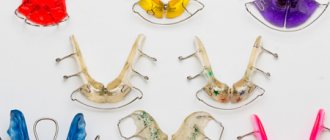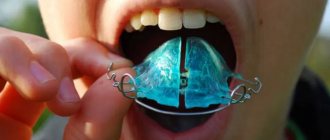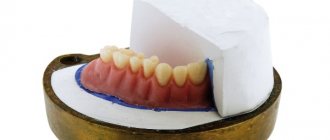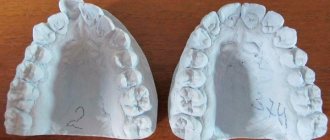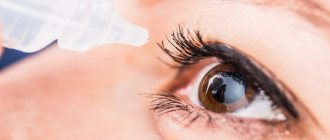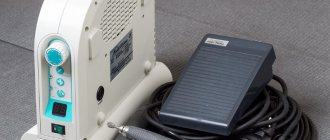500
Mechanical orthodontic devices use screws, labial and oral archwires, springs, and elastomers to generate force.
The screws create an intermittent force that decreases relatively quickly from maximum to low, after which the screw is activated again.
Arcs, springs and elastomers are used in devices with constant force, which do not require activation at all or are activated less often than screw ones.
Item overview
The Coffin spring is a wire figure in the form of a ring, the ends of which, not reaching each other, are bent to the sides. The force it creates is directed along a line passing through the open ends.
The latter are attached to the metal or polymer parts of the device by soldering or during the polymerization of the acrylic base (filled with a hardening polymer).
The element is used mainly as a power element of devices, to expand and lengthen the upper dental arch . Placed with its central, rounded part in the palatal recess, and resting its ends on the segments of the base, Coffin’s design organically fits into the apparatus and the upper jaw.
To expand the mandible, the Koller zigzag design is usually used.
The advantages of Coffin's design are:
- ease of manufacture;
- the ability, depending on the location, to expand and lengthen the top row in the segment in which it is required.
Disadvantage – inability to use for anomalies of the lower jaw.
For what purpose is the Marco Ross apparatus installed in orthodontics, and how does the device work?
Come here to take a closer look at Nord's apparatus.
At this address https://www.vash-dentist.ru/ortodontiya/plastinyi/profilakticheskimi-apparatami.html we will talk about modern preventive orthodontic devices for children.
Derichsweiler apparatus
The design is a mechanism that consists of main rings and corrective arcs. The support rings are fixed on the back teeth, where there is an attached lock on which the arches are attached.
They converge near the palatal arch, where the activator is located. This is a screw that transmits systematic pressure to the palate. The palatal suture expands, resulting in the jaw becoming wider. The gap that is formed when the palate opens is filled after some time with other soft tissue.
The device is prescribed for narrowing of the jaw arch during the first mixed bite. If the disease has formed in the permanent dentition, then the unit will have the least result, because it cannot cope with the hardened palatal suture. The device has its advantages:
- The dental expander has a plastic effect during correction, and there is no discomfort while wearing.
- The device cannot be removed independently, so correction is carried out in a minimum period of time.
- The device does not damage delicate gum tissue.
Like any device, the design has disadvantages. On the first day of wearing, maximum salivation and impaired pronunciation of words are noticed. Sometimes the surface of the tongue is injured. It is impossible to adjust the device yourself; to do this you need to visit a dentist.
Varieties
There are the following types of Coffin springs. Depending on the number of circuits:
- single (wire goes in one row);
- double (the wire is laid in two rows, i.e., in fact, there are 2 almost identical structures, one of which is inserted into the other, as a result of which the force they create increases).
The elasticity and movement of the element is affected by the size of its ring. Small allows you to place two products in the base, facing each other with closed parts. In addition to compactness, they are characterized by low stroke and high rigidity.
Springs with a larger ring have less rigidity but greater travel. They need activation more rarely than with small ones.
Manufacturing technique
The Coffin spring can be made from wire Ø 0.7-1.5 mm, length 70-80 mm, or from standard blanks, by adjusting them to a specific jaw.
The new design is made on a plaster model of the upper jaw in the following sequence:
- In the palatal recess of the model, the configuration of the device is drawn with a pencil.
- In accordance with the drawing, one or two contours of the product are formed from wire using round pliers. With a double circuit, the inner one is made of wire of a smaller diameter (0.6-0.7 mm) than the outer one (0.8-0.9 mm). The distance between them should be 1.0-1.5 mm.
- A gasket 0.6-0.7 mm thick is placed under the spring. This is necessary so that the wire does not touch or injure the palate.
- The ends of the wire are connected to the base - by soldering or pouring acrylic.
The combination and relative position in the apparatus depends on the tasks facing the orthodontist, which may be the following:
- Expansion is necessary in the front part of the jaw (in the canine area). In this case, the single or double structure is laid with the open part forward.
- What is required is mainly expansion of the posterior part of the dentition. A single-circuit or double-circuit spring is laid with the open part backwards.
- Uniform expansion of the distal and medial area is necessary. In this case, you can use 2 options. In the first, place small-diameter springs next to each other with closed parts.
Then their open ends will be located in the distal and medial segments, ensuring uniform expansion of both.The second option uses large springs, superimposed on each other so that the open part of one is directed forward, the other - back.
- Simultaneous expansion and lengthening of the dentition is required. In this case, 3 small products are used, laid close to each other at an angle of 120°.
Under their combined action, simultaneous expansion and lengthening of the dentition will occur. In principle, it is possible to use 4 small springs, placed with their open part in those places where expansion is required.
Review of removable mechanical orthodontic appliances for children.
This publication is all about the Schwartz apparatus.
Here https://www.vash-dentist.ru/ortodontiya/plastinyi/apparata-bidermana.html evaluate the aesthetic indicator of the Biderman apparatus using photos of patients.
Upper jaw correction device
The device is designed to expand the upper jaw and change the permanent or mixed bite. The typical design consists of main rings that are placed on the sides of the teeth. One pair is placed on the premolars, and the other on the last teeth. The ring is used to solder power arcs arranged in a cross-shaped manner. In the central part of the device, in its middle, there is a special screw. It is necessary to activate the structure and provide continuous pressure on the side of the jaw.
Advantages of the device for expanding the upper jaw:
- It has a pronounced force effect, due to this, expansion occurs in a minimum time.
- Correcting a mixed bite takes about 30 days.
- With a permanent bite, problems are corrected within 4 months.
- The design moves the teeth body-wise.
- In this case, the jaw row spreads out to the sides, but the roots remain in their own holes.
- There is no increase in the depression in the gums.
- You can activate the design yourself. This is done using a special key.
- Activation is done once every 48 hours.
Disadvantages include damage to the tongue and rubbing of the tissues of the palate. To get a quick result, activation is carried out at 1 mm. This causes discomfort during therapy. The mechanism will require auxiliary means to clean the structure. Viscous and fermented foods should not be included in the diet.
Operating principle
The mechanism of action of the element does not differ from other power elements that create constant corrective forces. The specific places of application and direction of force are determined by the design of the device.
In general, depending on the number, type and location in the apparatus, Coffin’s designs can provide uniform and uneven expansion of the dentition, create free space on it, move and/or tilt teeth in the distal mesial direction.
Indications for expanding the dentition
If the patient does not have the normal width of the dentition, then with the development of a crossbite, an expander is placed. Expansion is prescribed if the anomaly involves several teeth. Also, surgery will be required for mesial occlusion with a grade 3 slope according to Engle, with micrognathia and protrusion of the incisors.
The use of a device for jaw expansion is a gentle and correct method. Used to correct mixed or permanent dentition. There is a slight impact on the dentition. Therefore, the method can be applied to a child.
Reduced dentition is considered a common disease; it has different clinical manifestations. To treat anomalies, professionals use various installations. For example, a device for breaking the palatal suture is popular. For each indication, special methods have been developed that differ in the mechanism of action. Doctors often combine several methods at the same time.
Reviews
The design of the Coffin spring is particularly favorable for use in palatal expansion devices. If your child has had this surgery, there is a possibility that their device may have had a Coffin design installed.
If so, tell us what the result of the correction was? Were the hopes placed on it justified? You will find the comment form at the bottom of the page.
If you find an error, please select a piece of text and press Ctrl+Enter.
Tags: bite correction plates for teeth straightening
Did you like the article? stay tuned
Previous article
Expansion of the upper jaw in early mixed dentition using the Marco Ross apparatus
Next article
Instructions for using Pulposeptin paste in dentistry and a brief description of the product
Distractor for the lower jaw
This device stands out among other devices. It consists of a smooth body on which a self-expanding screw and slide are placed, and there are also levers with wedge-shaped ends. With its help, crossbite is corrected.
The device eliminates the anomaly and fills the emerging space in the bone tissue. The design has different types, they are aimed at solving various problems that are associated with a narrowing of the dental arch. This allows the use of a distractor to treat children.

